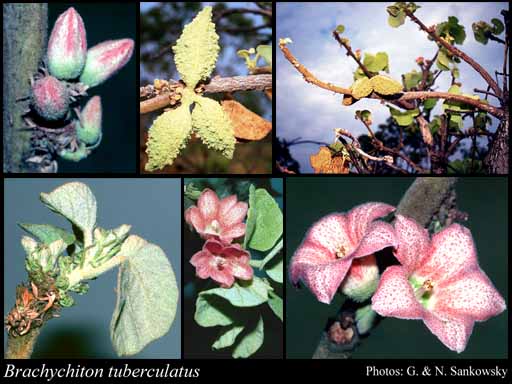- Reference
- Austral.Syst.Bot. 1:303 (1989)
- Conservation Code
- Priority Three
- Naturalised Status
- Native to Western Australia
- Name Status
- Current
Shrub or tree, 2-7 m high. Fl. cream-green/orange-red, Apr or Aug to Nov. Red or yellow sand. Undulating plains.

Scientific Description
Tree, with hairy stems. Leaves 150-320 mm long, 115-310 mm wide, not lobed; margins entire; hairy, with stellate hairswith scales absent, Sessile glands absent; stipules present but early deciduous (only visible on youngest leaves). Perianth of two whorls but the corolla reduced to small scales or tiny lobes at the base of the ovary or of one whorl only (the visible whorl is a calyx, sometimes petaloid). Pedicel present, 10-14 mm long; glabrous. Epicalyx (extra segments or 'bracteoles' immediately below the calyx) absent. Calyx green, cream, red or orange, 25-27 mm long, the lobes fused half or more of their length, Sessile glands absent, stellate hairs present, scales absent, Terminal appendages absent, number of ribs absent. Stamens many, united and arising from a staminal tube around the style; filaments present, 0.8-1 mm long; anthers 1.8-2 mm long, indumentum absent (anthers glabrous). Staminodes absent, appendages absent. Ovary hairs or scales present, simple hairs absent, stellate hairs present, gland-tipped hairs absent; styles several, free and separate, arising from the summit of the ovary, 15 mm long, with five style branches or lobes, hairy for most of length, wing absent. Fruits indehiscent and splitting into sections (schizocarps), length-width ratio at least 1.5 times as long as wide, mericarps smooth, hairs and scales absent; apex rounded; prickles absent (except perhaps a terminal awn); terminal awns or spines absent; calyx deciduous before maturity, not accrescent; carpels 5; seeds per loculus 2-4 or ≥5. Flowering time April, August, September, October or November. Distribution Botanical Province Northern, IBRA Bioregion Victoria Bonaparte. Conservation Code Priority Three (P3).
Distribution
- IBRA Regions
- Victoria Bonaparte.
- IBRA Subregions
- Keep.
- Local Government Areas (LGAs)
- Wyndham-East Kimberley.